CEE DOG
New member
- Jul 12, 2009
- 7,358
- 0
Review: CarPro Tar X
Introduction:
I first heard about this product and saw pictures of it a couple months ago. The color of it grabbed my attention right away and I’ve been excited and curious to find out if it is as effective as it is attention grabbing.
Product Claims:
Tar X derives its power from the solvents extracted from orange peels. This product contains no chlorinated solvents or harsh chemicals and is not corrosive. It is over 60% active ingredients. Tar X will leave surfaces clean in one step. Use for all purpose degreasing tar and asphalt removal, insect, tire mark, adhesives spot removal, traffic film and many other tough cleaning jobs. Use this product where a tough solvent or tar remover is needed.
Details:
1.- Packaging: Varies based on size (20.3 oz. is a plastic bottle with trigger)
2.- Directions: Clearly labeled
3.- Viscosity: A little thinner than baby oil (See videos)
4.- Color: Fluorescent green
5.- Scent: Citrus
6.- Regular Price: 1.7 oz. (50ml) = $5.99
7.- Regular Price: 20.3 oz. (600ml) = $ To be determined
8.- Regular Price: 33.8 oz. (1000ml) = $ To be determined
9.- Regular Price: 169.0 oz. (5000ml) = $ To be determined
10.- Manufacturer: CarPro
11.- Made in: Korea
00-Product

01-Humidity as well as Ambient and Surface Temperatures (Early Morning)
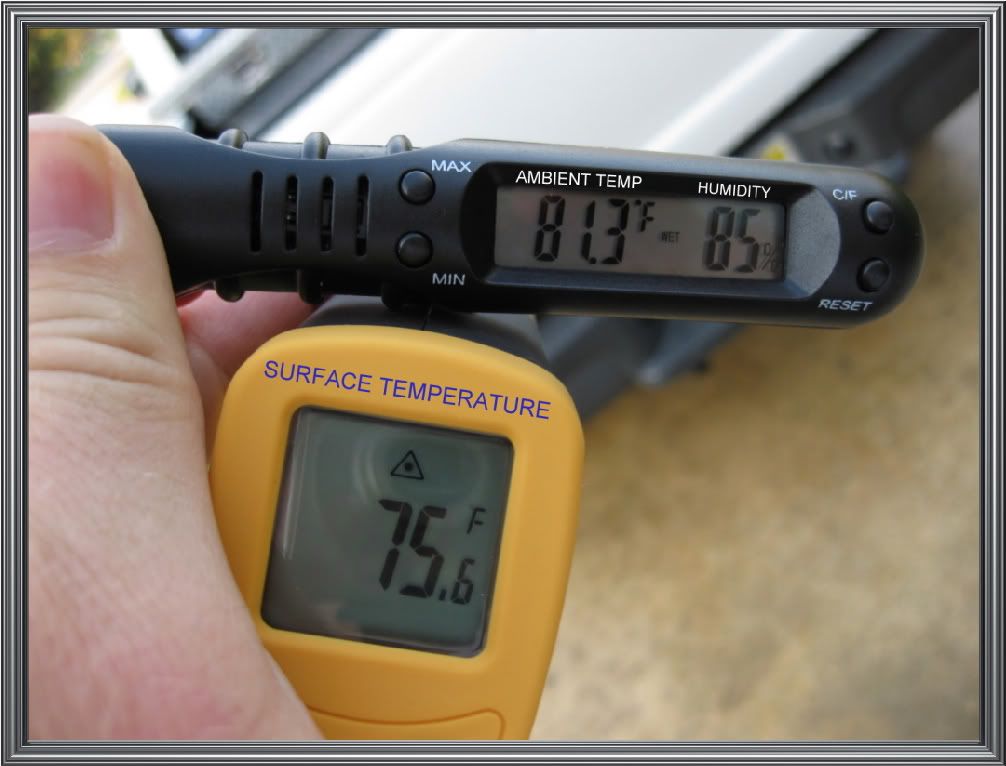
Getting Started:
I began by washing the truck down with UPGW followed by OPC 3:1. After a thorough rinse I very quickly went over it with the Master Blaster to remove the excess water. As I was circling the vehicle I found a couple prime candidates for our visual tests which you will find in part 1 below. After recording the results of “Part 1” I moved on. I decontaminated the majority of the vehicle with both Iron X and Tar X. On the hood I taped off some sections for our feature test, which you will find in Part 2 a little further down.
PART 1 (DOWN TO BUSINESS)
After shaking the bottle I released a couple sprays of Tar X onto the offending residue you see below.
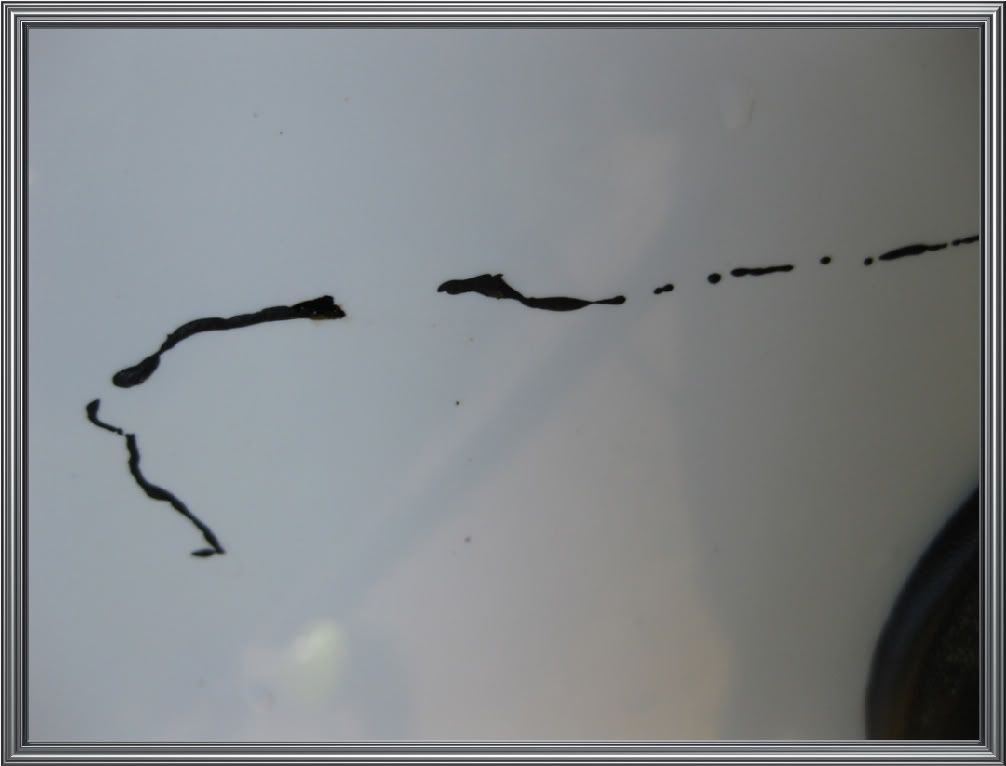
Instantly it began to melt the tar away.

After approximately 2 minutes

After approximately 6 minutes
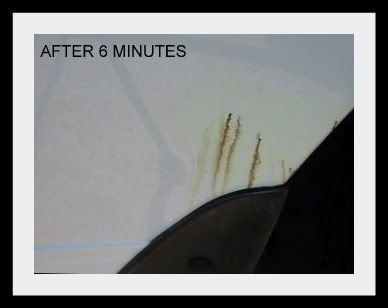
After wiping with an mf wash mitt and rinsing
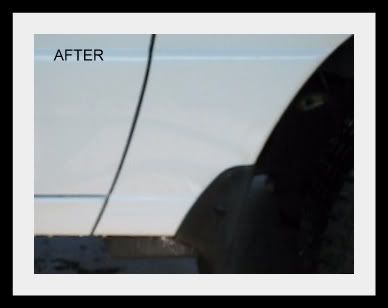
After allowing it to sit for about 7 minutes (while I completed other tasks) I used my wash mitt to wipe away the residue and then rinsed the area thoroughly. A second area was also recorded with the wait time approximately 4 minutes.
Please see the video below!
Video: Tar X
PART 2 (DECONTAMINATION TEST!)
This test was created to determine how well Tar X and Iron X remove contaminants and study to what degree they are able to replace claying. I taped off 4 sections when all was said and done (not including the X section you will see in the video).
Setup Before Start of Video
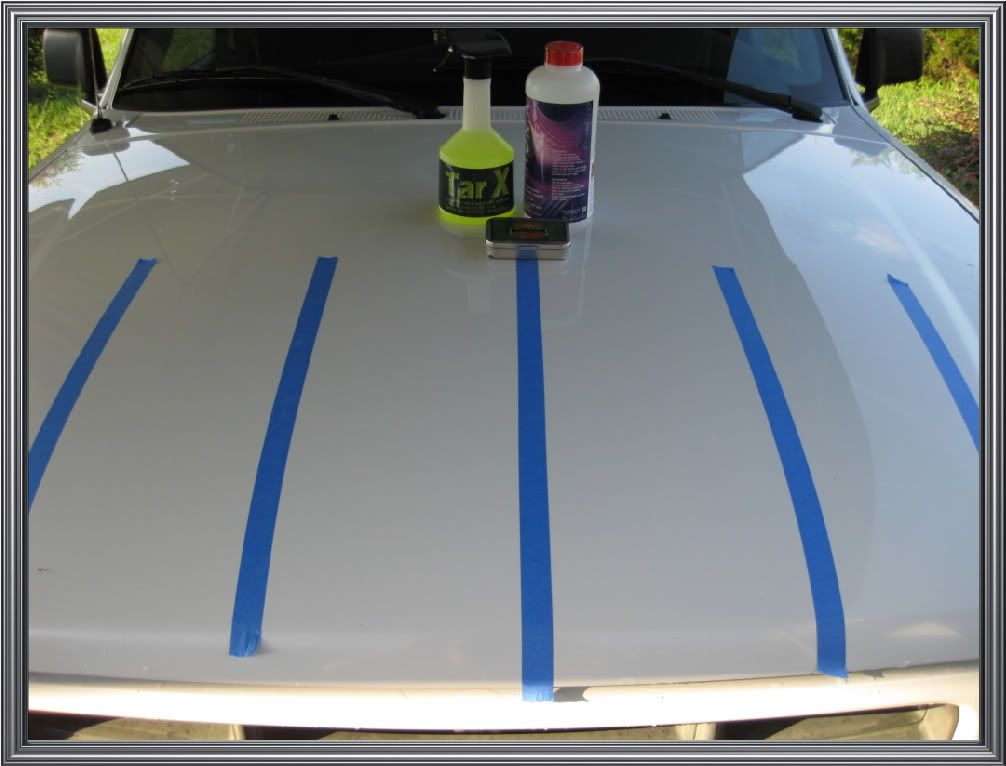
As shown in the following video the process will move from left to right as follows:
1.-Tar X
2.-Iron X
3.-Tar X + Iron X
4.-Nothing
After application, dwelling, and removal of the CarPro decontamination products to the first 3 sections I broke off a small piece of clay and clayed each section.
The following testing and video footage took place over a 25-minute timeframe. The final video has been sped up by increasing the speed of most of the video and cutting out the ”dead time”. The Tar X and Iron X were allowed to dwell 5 minutes +/- before being removed.
Video (Must See): Decontamination Test Tar X / Iron X / Clay
Section where Tar X was applied BEFORE CLAYING
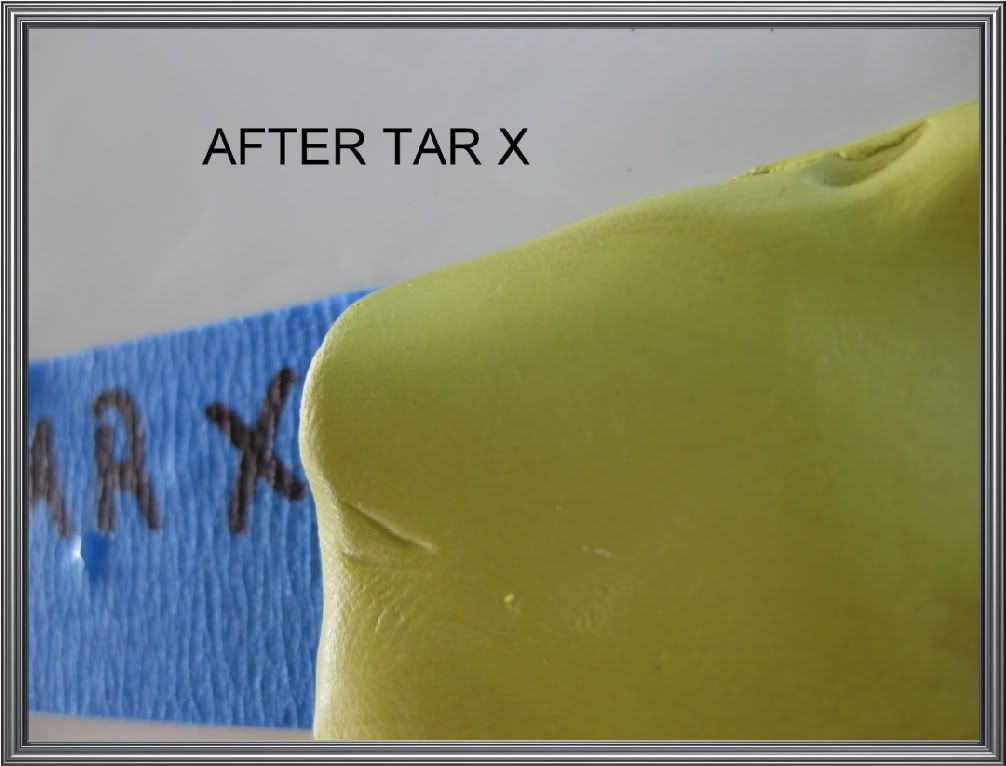
Section where Iron X was applied BEFORE CLAYING
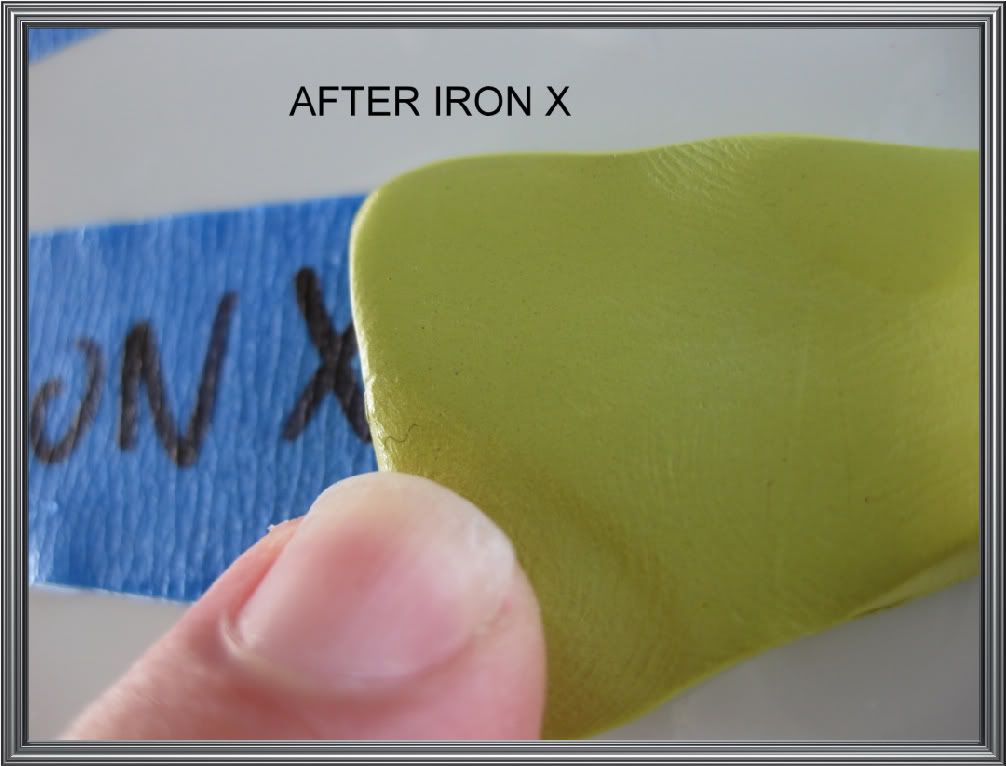
Section where BOTH Iron X & Tar X was applied BEFORE CLAYING
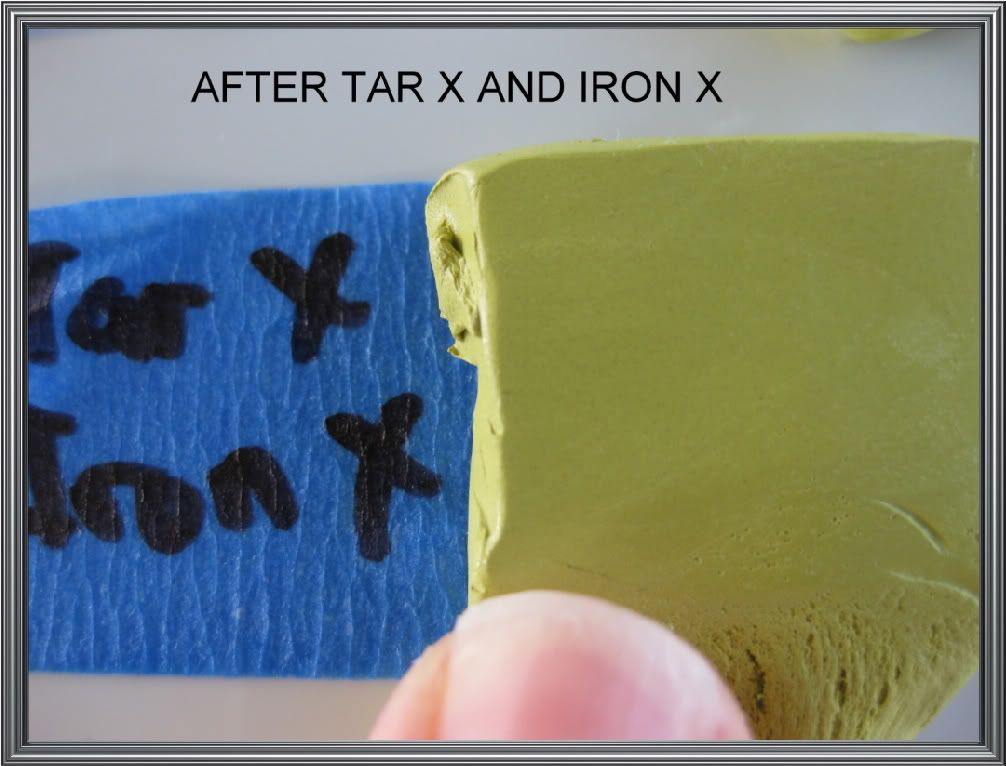
Section that where neither product was used BEFORE CLAYING

Observation:
Using clay after Tar X did show a difference in the amount of contamination left on the paint. Used in concert with Iron X the paint felt much smoother and the clay found virtually no visible contamination.
Lesson Learned:
I attempted to compensate with small pieces of clay but I should have taped off larger sections in order to properly show the difference in the amount of contaminants between the 4 pieces of clay. While the results were obvious the difference would build exponentially with larger areas and show a dramatic difference.
Action Taken:
After studying the pieces of clay from this test I completed the decontamination of this truck with Iron X and Tar X and without the use of clay.
PART 3 (Color Tracers on both light and dark paint)
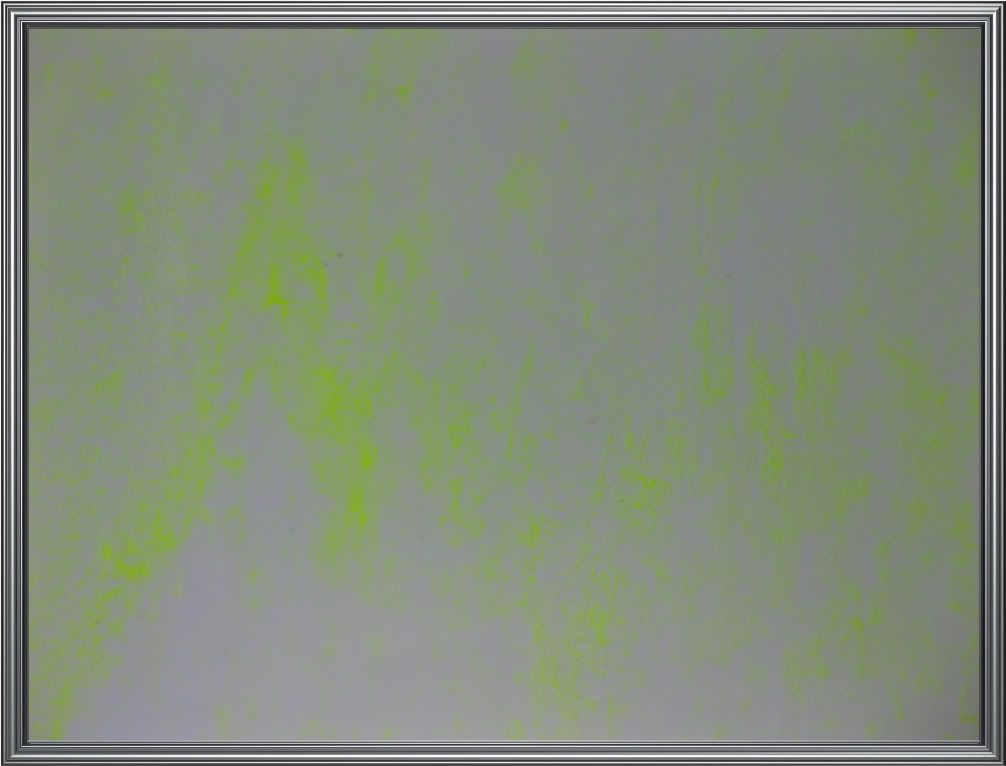


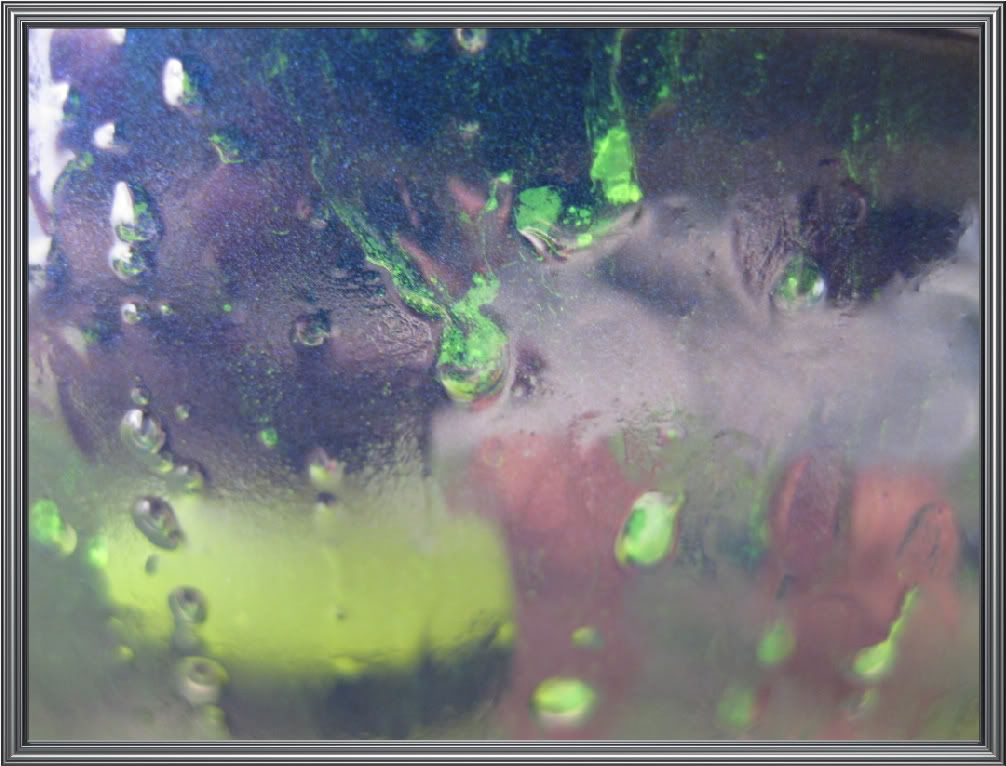
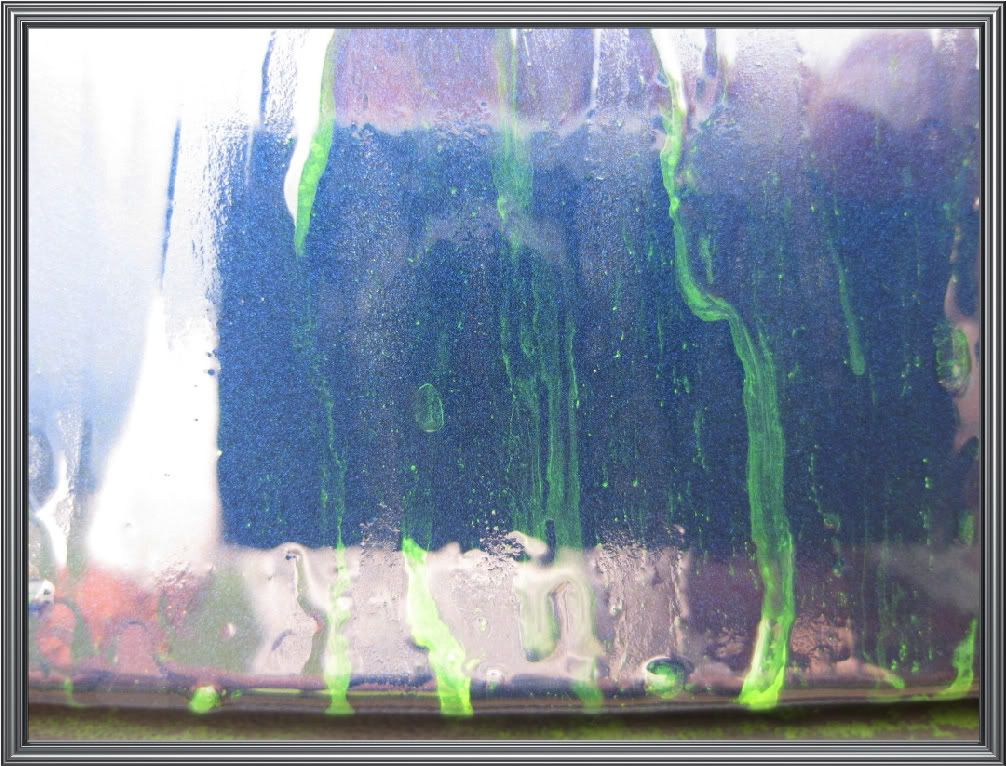
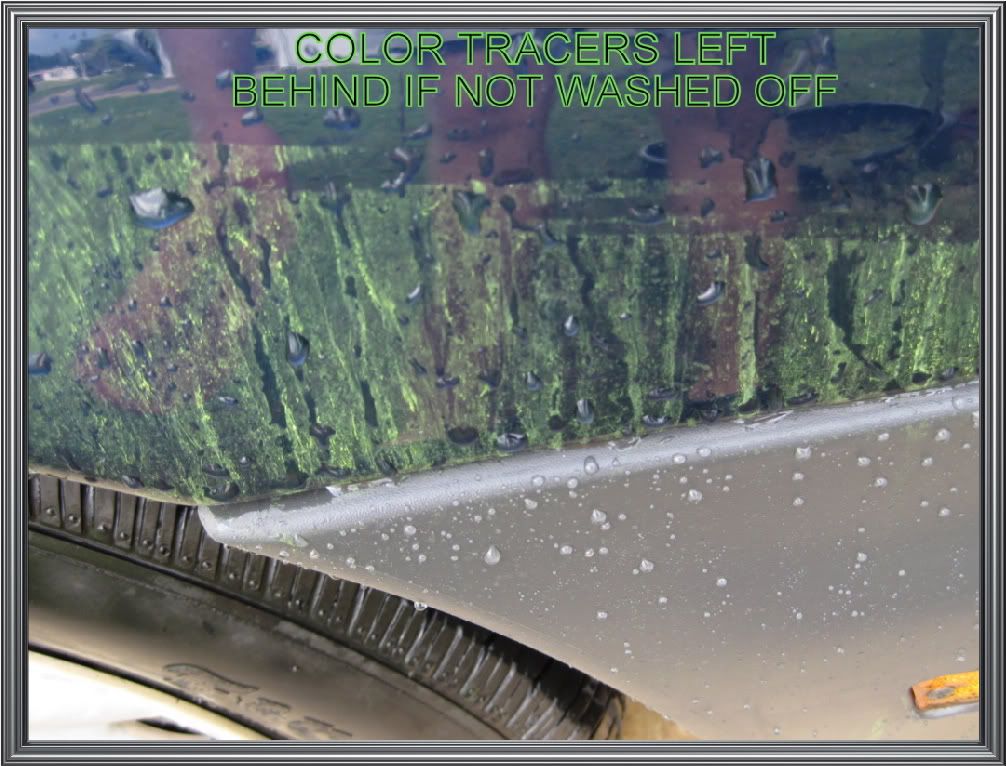
Time for a glass of iced tea in the glass my buddy gave me many years ago.
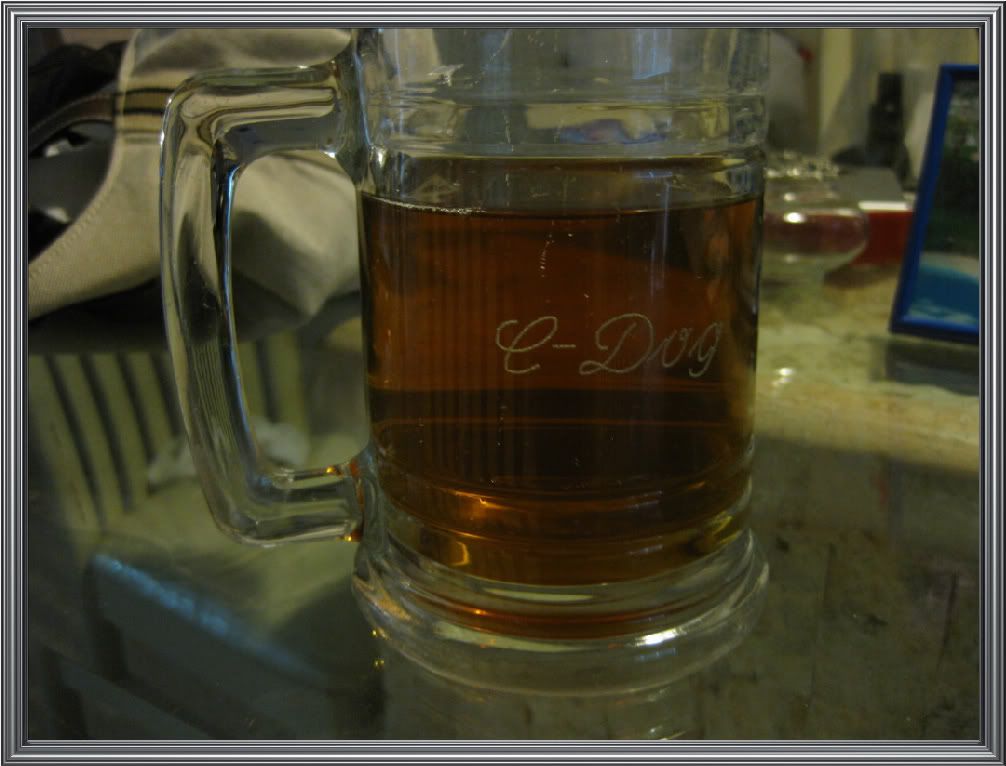
My Tips and Method of Application:
Tar X is a (citrus based) solvent so it’s recommended that you apply it to a dry surface where it won’t be diluted by water.
After shaking the bottle and spraying onto a dry surface I allow it to dwell for anywhere from 2 to 10 minutes depending on how thick the tar is and the situation of the environment. It should not be allowed to dry on surfaces or be applied in direct sunlight.
Pros:
1.- Dissolves Tar, bugs, adhesives, and other organic matter
2.- Ease of use
3.- Versatility: Safe on all automobile surfaces including plastics
4.- All Natural Solvents
5.- Color Tracers work well on both light and dark paints
6.- Scent
???:
1.- Price: We will have to see where the bar is set when AutoGeek releases the remaining sizes
2.- Do those cool glow color tracers make you smile too?
3.- FYI: the glow tracers don’t glow in the dark but they work great in the day, which is what matters
4.- Taping off a panel where I’m using Tar X? J
Cons:
1.- Trigger: Quality of trigger head on 20.3 oz bottle could be improved
Final Observations and Summary:
For me Tar X is much more versatile and fills a void between Tarminator and Tarmalade. I haven’t used Tardis so I can’t compare with that product. What I can say is Tar X works as advertised and is safe on all surfaces, which is a benefit over Tarminator. Tarminator is cheaper but is a heavy chemical that can harm some plastics. Tarmalade is good for isolated spots but Tar X dissolved the tar I tested it on and then wiped off more easily. As a decontamination step (or for easily removing isolated spots) this product is a winner in my book. I also plan to continue testing to discover how much clay time I can skip when Tar X is used next to its brother “Iron X”.
I did notice the square nozzle didn’t feel like the highest quality and could be improved. The trigger itself was quite functional and released a steady stream. The internal components of the triggers are entirely plastic and have no metal components that can rust.
I’m anxious to find out what the pricing will be as AutoGeek begins to stock this product and list it. I’m hopeful that they offer it cheaper than the price of IronX.
Tar X does not glow in the dark in my experience but obviously that doesn’t matter. Nobody is detailing without some type of lighting. The helpful part is that it glows in the day!
Q&A with Avi of CarPro:
Avi, I’ve compiled a few questions for a Q&A to add to my Tar X review.
1Q.-Is there a possibility of designing another version of Iron X that contains the Tar removal abilities of Tar X or would the two compounds react adversely to one another?
1A.- This will be very hard to do since ironx is water based and tarx is solvent based, but I thought about it and it will be for sure in the future, I want to save time for de-con procedure for customers of course, but it needs more lab time to create it.
2Q.-If using both Tar X and Iron X to decontaminate a vehicle is it necessary to apply, agitate and remove them separately as I have done? It is logical to me that applying them both to the surface and letting them dwell together they would effectively dilute one another to some extent. Is this the case?
2A.-Yes, you must separate between the two procedures since again they are different in chemical base (water vs. solvent) so it’s better to rinse between them each time, and it is more effective on dried surface for better cling.
3Q.-I am curious and I can’t help but ask… What thought led you come up with the addition of glow tracers to Tar X?
3A.- Nice question, since most other de-tar chemicals are transparent and most of them can be harmful to plastic, vinyl, and rubber, I thought how can I make sure customers will wash thoroughly afterwards. So adding color powder was the idea. This allows customers to be able to see and know not to leave any chemicals on the surface. The fluorescent powder was "by the way" while searching what kind of color to add. I would like to mention that this powder doesn’t have any bonding properties with the surfaces so there is no risk in spraying it on because pressure wash, wash mitt, or sponge will remove it easily.
Thank you for taking the time to answer my questions. It’s much appreciated by all the readers as well.
-End of Q&A-
Thank you for taking the time to read my review!
A special thanks to Dave for giving me the idea of bordering my photos. I’m still playing with that some.
Questions and comments are welcome!
Cheers!
I will leave you with a couple before and after pictures from the polishing stage where I began testing the beta CarPro polish and some beading pictures from the resulting coat of CQuartz. The Flex Rotary was the machine used for polishing. The time crunch was on to make sure I had the CQ on and off with cure time to spare before the rain came. Clouds rolled in and after sun shots were taken on the next day and the day after.
BEFORE

AFTER

BEFORE

AFTER

AFTER (LED LIGHTS)
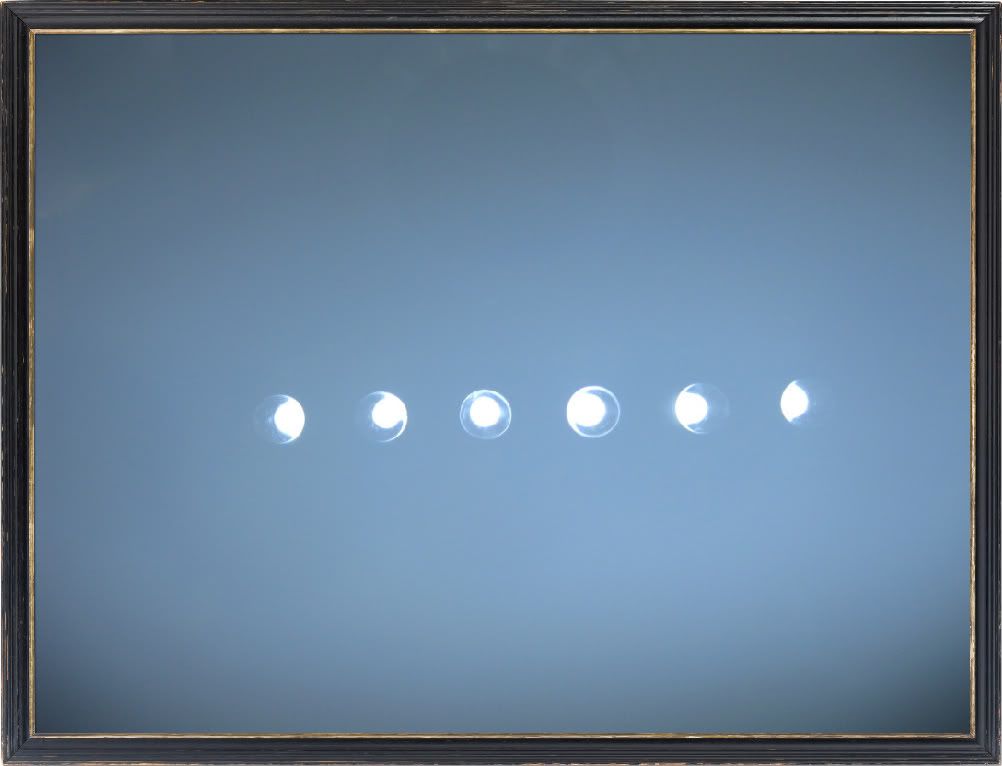
CONDENSATION BEADS

CONDENSATION BEADS

CONDENSATION BEADS

SKY's the LIMIT CAR CARE (INDEX of REVIEWS)
Introduction:
I first heard about this product and saw pictures of it a couple months ago. The color of it grabbed my attention right away and I’ve been excited and curious to find out if it is as effective as it is attention grabbing.
Product Claims:
Tar X derives its power from the solvents extracted from orange peels. This product contains no chlorinated solvents or harsh chemicals and is not corrosive. It is over 60% active ingredients. Tar X will leave surfaces clean in one step. Use for all purpose degreasing tar and asphalt removal, insect, tire mark, adhesives spot removal, traffic film and many other tough cleaning jobs. Use this product where a tough solvent or tar remover is needed.
Details:
1.- Packaging: Varies based on size (20.3 oz. is a plastic bottle with trigger)
2.- Directions: Clearly labeled
3.- Viscosity: A little thinner than baby oil (See videos)
4.- Color: Fluorescent green
5.- Scent: Citrus
6.- Regular Price: 1.7 oz. (50ml) = $5.99
7.- Regular Price: 20.3 oz. (600ml) = $ To be determined
8.- Regular Price: 33.8 oz. (1000ml) = $ To be determined
9.- Regular Price: 169.0 oz. (5000ml) = $ To be determined
10.- Manufacturer: CarPro
11.- Made in: Korea
00-Product

01-Humidity as well as Ambient and Surface Temperatures (Early Morning)

Getting Started:
I began by washing the truck down with UPGW followed by OPC 3:1. After a thorough rinse I very quickly went over it with the Master Blaster to remove the excess water. As I was circling the vehicle I found a couple prime candidates for our visual tests which you will find in part 1 below. After recording the results of “Part 1” I moved on. I decontaminated the majority of the vehicle with both Iron X and Tar X. On the hood I taped off some sections for our feature test, which you will find in Part 2 a little further down.
PART 1 (DOWN TO BUSINESS)
After shaking the bottle I released a couple sprays of Tar X onto the offending residue you see below.

Instantly it began to melt the tar away.

After approximately 2 minutes

After approximately 6 minutes

After wiping with an mf wash mitt and rinsing

After allowing it to sit for about 7 minutes (while I completed other tasks) I used my wash mitt to wipe away the residue and then rinsed the area thoroughly. A second area was also recorded with the wait time approximately 4 minutes.
Please see the video below!
Video: Tar X
PART 2 (DECONTAMINATION TEST!)
This test was created to determine how well Tar X and Iron X remove contaminants and study to what degree they are able to replace claying. I taped off 4 sections when all was said and done (not including the X section you will see in the video).
Setup Before Start of Video

As shown in the following video the process will move from left to right as follows:
1.-Tar X
2.-Iron X
3.-Tar X + Iron X
4.-Nothing
After application, dwelling, and removal of the CarPro decontamination products to the first 3 sections I broke off a small piece of clay and clayed each section.
The following testing and video footage took place over a 25-minute timeframe. The final video has been sped up by increasing the speed of most of the video and cutting out the ”dead time”. The Tar X and Iron X were allowed to dwell 5 minutes +/- before being removed.
Video (Must See): Decontamination Test Tar X / Iron X / Clay
Section where Tar X was applied BEFORE CLAYING

Section where Iron X was applied BEFORE CLAYING

Section where BOTH Iron X & Tar X was applied BEFORE CLAYING

Section that where neither product was used BEFORE CLAYING

Observation:
Using clay after Tar X did show a difference in the amount of contamination left on the paint. Used in concert with Iron X the paint felt much smoother and the clay found virtually no visible contamination.
Lesson Learned:
I attempted to compensate with small pieces of clay but I should have taped off larger sections in order to properly show the difference in the amount of contaminants between the 4 pieces of clay. While the results were obvious the difference would build exponentially with larger areas and show a dramatic difference.
Action Taken:
After studying the pieces of clay from this test I completed the decontamination of this truck with Iron X and Tar X and without the use of clay.
PART 3 (Color Tracers on both light and dark paint)






Time for a glass of iced tea in the glass my buddy gave me many years ago.

My Tips and Method of Application:
Tar X is a (citrus based) solvent so it’s recommended that you apply it to a dry surface where it won’t be diluted by water.
After shaking the bottle and spraying onto a dry surface I allow it to dwell for anywhere from 2 to 10 minutes depending on how thick the tar is and the situation of the environment. It should not be allowed to dry on surfaces or be applied in direct sunlight.
Pros:
1.- Dissolves Tar, bugs, adhesives, and other organic matter
2.- Ease of use
3.- Versatility: Safe on all automobile surfaces including plastics
4.- All Natural Solvents
5.- Color Tracers work well on both light and dark paints
6.- Scent
???:
1.- Price: We will have to see where the bar is set when AutoGeek releases the remaining sizes
2.- Do those cool glow color tracers make you smile too?
3.- FYI: the glow tracers don’t glow in the dark but they work great in the day, which is what matters
4.- Taping off a panel where I’m using Tar X? J
Cons:
1.- Trigger: Quality of trigger head on 20.3 oz bottle could be improved
Final Observations and Summary:
For me Tar X is much more versatile and fills a void between Tarminator and Tarmalade. I haven’t used Tardis so I can’t compare with that product. What I can say is Tar X works as advertised and is safe on all surfaces, which is a benefit over Tarminator. Tarminator is cheaper but is a heavy chemical that can harm some plastics. Tarmalade is good for isolated spots but Tar X dissolved the tar I tested it on and then wiped off more easily. As a decontamination step (or for easily removing isolated spots) this product is a winner in my book. I also plan to continue testing to discover how much clay time I can skip when Tar X is used next to its brother “Iron X”.
I did notice the square nozzle didn’t feel like the highest quality and could be improved. The trigger itself was quite functional and released a steady stream. The internal components of the triggers are entirely plastic and have no metal components that can rust.
I’m anxious to find out what the pricing will be as AutoGeek begins to stock this product and list it. I’m hopeful that they offer it cheaper than the price of IronX.
Tar X does not glow in the dark in my experience but obviously that doesn’t matter. Nobody is detailing without some type of lighting. The helpful part is that it glows in the day!
Q&A with Avi of CarPro:
Avi, I’ve compiled a few questions for a Q&A to add to my Tar X review.
1Q.-Is there a possibility of designing another version of Iron X that contains the Tar removal abilities of Tar X or would the two compounds react adversely to one another?
1A.- This will be very hard to do since ironx is water based and tarx is solvent based, but I thought about it and it will be for sure in the future, I want to save time for de-con procedure for customers of course, but it needs more lab time to create it.
2Q.-If using both Tar X and Iron X to decontaminate a vehicle is it necessary to apply, agitate and remove them separately as I have done? It is logical to me that applying them both to the surface and letting them dwell together they would effectively dilute one another to some extent. Is this the case?
2A.-Yes, you must separate between the two procedures since again they are different in chemical base (water vs. solvent) so it’s better to rinse between them each time, and it is more effective on dried surface for better cling.
3Q.-I am curious and I can’t help but ask… What thought led you come up with the addition of glow tracers to Tar X?
3A.- Nice question, since most other de-tar chemicals are transparent and most of them can be harmful to plastic, vinyl, and rubber, I thought how can I make sure customers will wash thoroughly afterwards. So adding color powder was the idea. This allows customers to be able to see and know not to leave any chemicals on the surface. The fluorescent powder was "by the way" while searching what kind of color to add. I would like to mention that this powder doesn’t have any bonding properties with the surfaces so there is no risk in spraying it on because pressure wash, wash mitt, or sponge will remove it easily.
Thank you for taking the time to answer my questions. It’s much appreciated by all the readers as well.
-End of Q&A-
Thank you for taking the time to read my review!
A special thanks to Dave for giving me the idea of bordering my photos. I’m still playing with that some.
Questions and comments are welcome!
Cheers!
I will leave you with a couple before and after pictures from the polishing stage where I began testing the beta CarPro polish and some beading pictures from the resulting coat of CQuartz. The Flex Rotary was the machine used for polishing. The time crunch was on to make sure I had the CQ on and off with cure time to spare before the rain came. Clouds rolled in and after sun shots were taken on the next day and the day after.
BEFORE

AFTER

BEFORE

AFTER

AFTER (LED LIGHTS)

CONDENSATION BEADS

CONDENSATION BEADS

CONDENSATION BEADS

SKY's the LIMIT CAR CARE (INDEX of REVIEWS)